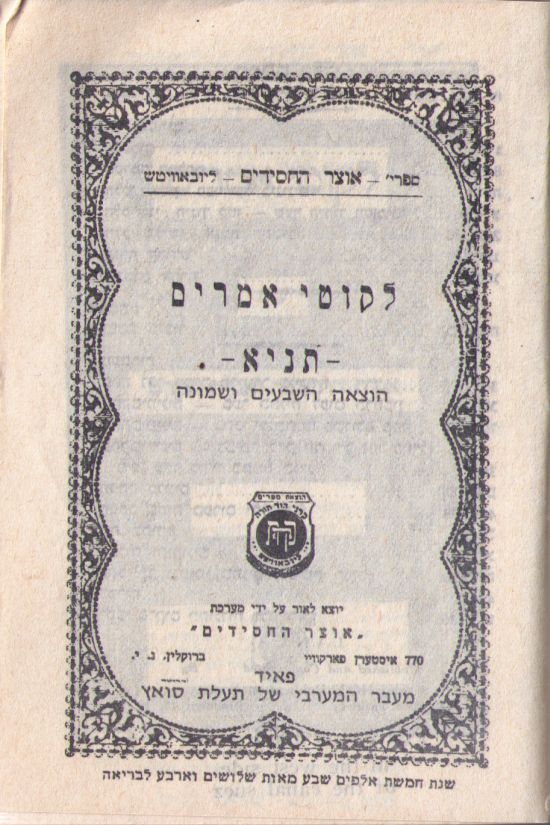|
Animal Soul
In Kabbalah, the animal soul (, ''nefesh habehamit'') is one of the two souls Jews possess. The animal soul animates the living body and is the source of both animalistic desires and inherent Jewish traits like kindness and compassion, as noted in '' Tanya'', a primary text of the Chabad movement and much of Hasidism, in general. While its primary inclination is to seek worldly, physical pleasures, the animal soul can be trained to primarily pursue spiritual pleasures with the guidance of the divine soul. Transforming the animal soul While the animal soul is still attached to worldly, physical pleasures, it is synonymous with the ''yetzer hara'', the evil inclination. However, the ''nefesh habehamit'' is not inherently evil; it merely seeks pleasure. Through persistent, joyous exposure to Torah study and observance of ''mitzvot'', the ''nefesh habehamit'' can be trained to desire spiritual and divine pleasures. In its refined state, it is often termed the ''nefesh hachiyunit'', th ... [...More Info...] [...Related Items...] OR: [Wikipedia] [Google] [Baidu] |
Kabbalah
Kabbalah or Qabalah ( ; , ; ) is an esoteric method, discipline and school of thought in Jewish mysticism. It forms the foundation of Mysticism, mystical religious interpretations within Judaism. A traditional Kabbalist is called a Mekubbal (). List of Jewish Kabbalists, Jewish Kabbalists originally developed transmissions of the primary texts of Kabbalah within the realm of Jewish tradition and often use classical Jewish scriptures to explain and demonstrate its mystical teachings. Kabbalists hold these teachings to define the inner meaning of both the Hebrew Bible and traditional rabbinic literature and their formerly concealed transmitted dimension, as well as to explain the significance of Jewish religious observances. Historically, Kabbalah emerged from earlier forms of Jewish mysticism, in 12th- to 13th-century Golden age of Jewish culture in Spain, al-Andalus (Spain) and in Hakhmei Provence, and was reinterpreted during the Jewish mystical renaissance in 16th-century ... [...More Info...] [...Related Items...] OR: [Wikipedia] [Google] [Baidu] |
Hasidic Philosophy
Hasidic philosophy or Hasidism (), alternatively transliterated as Hasidut or Chassidus, consists of the teachings of the Hasidic movement, which are the teachings of the Hasidic ''rebbes'', often in the form of commentary on the Torah (the Five books of Moses) and Kabbalah (Jewish mysticism). Hasidism deals with a range of spiritual concepts such as God, the soul, and the Torah, dealing with esoteric matters but often making them understandable, applicable and finding practical expressions. With the spread of Hasidism throughout Ukraine, Galicia, Poland, and Russia, divergent schools emerged within Hasidism. Most if not all schools of Hasidic Judaism stress the central role of the Tzadik, or spiritual and communal leader, in the life of the individual Etymologically, the term, ''hasid'' is a title used for various pious individuals and by various Jewish groups since biblical times, and an earlier movement, the Hasidei Ashkenaz of medieval Germany was also called by this name. ... [...More Info...] [...Related Items...] OR: [Wikipedia] [Google] [Baidu] |
Kabbalistic Words And Phrases
Kabbalah or Qabalah ( ; , ; ) is an esoteric method, discipline and school of thought in Jewish mysticism. It forms the foundation of Mysticism, mystical religious interpretations within Judaism. A traditional Kabbalist is called a Mekubbal (). List of Jewish Kabbalists, Jewish Kabbalists originally developed transmissions of the primary texts of Kabbalah within the realm of Jewish tradition and often use classical Jewish scriptures to explain and demonstrate its mystical teachings. Kabbalists hold these teachings to define the inner meaning of both the Hebrew Bible and traditional rabbinic literature and their formerly concealed transmitted dimension, as well as to explain the significance of Jewish religious observances. Historically, Kabbalah emerged from earlier forms of Jewish mysticism, in 12th- to 13th-century Golden age of Jewish culture in Spain, al-Andalus (Spain) and in Hakhmei Provence, and was reinterpreted during the Jewish mystical renaissance in 16th-century ... [...More Info...] [...Related Items...] OR: [Wikipedia] [Google] [Baidu] |
Hasidic Thought
Hasidic philosophy or Hasidism (), alternatively transliterated as Hasidut or Chassidus, consists of the teachings of the Hasidic movement, which are the teachings of the Hasidic ''rebbes'', often in the form of commentary on the Torah (the Five books of Moses) and Kabbalah (Jewish mysticism). Hasidism deals with a range of spiritual concepts such as God, the soul, and the Torah, dealing with esoteric matters but often making them understandable, applicable and finding practical expressions. With the spread of Hasidism throughout Ukraine, Galicia, Poland, and Russia, divergent schools emerged within Hasidism. Most if not all schools of Hasidic Judaism stress the central role of the Tzadik, or spiritual and communal leader, in the life of the individual Etymologically, the term, ''hasid'' is a title used for various pious individuals and by various Jewish groups since biblical times, and an earlier movement, the Hasidei Ashkenaz of medieval Germany was also called by this name. ... [...More Info...] [...Related Items...] OR: [Wikipedia] [Google] [Baidu] |
Shneur Zalman Of Liadi
Shneur Zalman of Liadi, (; September 4, 1745 – December 15, 1812 O.S. / 18 Elul 5505 – 24 Tevet 5573) commonly known as the Alter Rebbe or Baal Hatanya, was a rabbi and the founder and first Rebbe of Chabad, a branch of Hasidic Judaism. He wrote many works and is best known for '' Shulchan Aruch HaRav'', '' Tanya'', and his ''Siddur Torah Or'', compiled according to the '' Nusach Ari''. Names Zalman is a Yiddish variant of Solomon and Shneur (or Shne'or) is a Yiddish composite of the two Hebrew words "shnei ohr" (שני אור "two lights"). He is also known as Shneur Zalman Baruchovitch, using the Russian patronymic of his father Baruch, and by a variety of other titles and acronyms including "Baal HaTanya VeHaShulchan Aruch'" ("Author of the Tanya and the Shulchan Aruch"), "Alter Rebbe" (Yiddish for "Old Rabbi"), " Admor HaZaken" (Hebrew for ″Our Old Master and Teacher″), "Rabbenu HaZaken" (Hebrew for "Our Old Rabbi"), "Rabbenu HaGadol" (Hebrew for "Our Great Rabb ... [...More Info...] [...Related Items...] OR: [Wikipedia] [Google] [Baidu] |
Behemoth
Behemoth (; , ''bəhēmōṯ'') is a beast from the biblical Book of Job, and is a form of the primeval chaos-monster created by God at the beginning of creation. Metaphorically, the name has come to be used for any extremely large or powerful entity. Etymology The Hebrew word ''behemoth'' has the same form as the plural of the Hebrew noun בהמה ''behemah'' meaning 'beast', suggesting an augmentative meaning 'great beast'. However, some theorize that the word might originate from an Egyptian word of the form '' pꜣ jḥ mw'' 'the water-ox' meaning 'hippopotamus', altered by folk etymology in Hebrew to resemble ''behemah''. However, this phrase with this meaning is unattested at any stage of Egyptian. Even before the decipherment of Ancient Egyptian in the early 19th century there was widespread identification of the biblical behemoth with the hippopotamus. The word for hippopotamus in Russian remains derivative of ''behemoth'' (бегемот), a meaning that entered the ... [...More Info...] [...Related Items...] OR: [Wikipedia] [Google] [Baidu] |
Soul
The soul is the purported Mind–body dualism, immaterial aspect or essence of a Outline of life forms, living being. It is typically believed to be Immortality, immortal and to exist apart from the material world. The three main theories that describe the relationship between the soul and the body are Interactionism (philosophy of mind), interactionism, Psychophysical parallelism, parallelism, and epiphenomenalism. Anthropology, Anthropologists and Psychology, psychologists have found that most humans are naturally inclined to believe in the existence of the soul and that they have interculturally distinguished between souls and bodies. The soul has been the central area of interest in philosophy since Ancient history, ancient times. Socrates envisioned the soul to possess a rational faculty, its practice being man's most godlike activity. Plato believed the soul to be the person's real self, an immaterial and immortal dweller of our lives that continues and thinks even after d ... [...More Info...] [...Related Items...] OR: [Wikipedia] [Google] [Baidu] |
Tefilin
Tefillin (Israeli Hebrew: / ; Ashkenazic pronunciation: ; Modern Hebrew pronunciation: ), or phylacteries, are a set of small black leather boxes with leather straps containing scrolls of parchment inscribed with verses from the Torah. Tefillin are worn by male adult Jews during weekday and Sunday morning prayers. In Orthodox and traditional communities, they are worn solely by men, while some Reform and Conservative (Masorti) communities allow them to be worn by Jewish adults regardless of gender. In Jewish law (halacha), women are exempt from most time-dependent positive commandments, which include tefillin, and unlike other time-dependent positive commandments, most halachic authorities prohibit them from fulfilling this commandment. Although "tefillin" is technically the plural form (the singular being "tefillah"), it is often used as a singular as well. The arm-tefillah (or ''shel yad'' iterally "of the hand" is placed on the upper (non-dominant) arm, and the strap wr ... [...More Info...] [...Related Items...] OR: [Wikipedia] [Google] [Baidu] |
Tzadik
Tzadik ( ''ṣaddīq'' , "righteous ne; also ''zadik'' or ''sadiq''; pl. ''tzadikim'' ''ṣadīqīm'') is a title in Judaism given to people considered righteous, such as biblical figures and later spiritual masters. The root of the word ''ṣadiq'', is '' ṣ- d- q'' ( ''tsedek''), which means "justice" or " righteousness". When applied to a righteous woman, the term is inflected as ''tzadeket'' singularly or ''tzidkaniot'' in the plural. ''Tzadik'' is also the root of the word '' tzedakah'' ('charity', literally 'righteousness'). The term ''tzadik'' "righteous", and its associated meanings, developed in rabbinic thought from its Talmudic contrast with ''hasid'' ("pious" honorific), to its exploration in ethical literature, and its esoteric spiritualisation in Kabbalah. Since the late 17th century, in Hasidic Judaism, the institution of the mystical tzadik as a divine channel assumed central importance, combining popularization of (hands-on) Jewish mysticism with soci ... [...More Info...] [...Related Items...] OR: [Wikipedia] [Google] [Baidu] |
Beinoni
The ''Tanya'' () is an early work of Hasidic philosophy, by Rabbi Shneur Zalman of Liadi, the founder of Chabad Hasidism, first published in 1796. Its formal title is ''Likkutei Amarim'' (, Hebrew language, Hebrew, "collection of statements") but is more commonly known by its first word (''tanya''), which in Aramaic means "it has been taught". Zalman is referring to a baraita in Niddah (Talmud), "Niddah" chapter 3 in the word’s first usage. The ''Tanya'' is composed of five sections that define Hasidic mystical psychology and theology as a handbook for daily spiritual life in Jewish observance. The ''Tanya'' is the main work of Chabad philosophy and the Chabad approach to Jewish mysticism, Hasidic mysticism, as it defines its general interpretation and method. The subsequent extensive library of the Chabad school, authored by successive leaders, builds upon the approach of the ''Tanya''. Chabad differed from mainstream Hasidism by its philosophical investigation and intell ... [...More Info...] [...Related Items...] OR: [Wikipedia] [Google] [Baidu] |
Deuteronomy
Deuteronomy (; ) is the fifth book of the Torah (in Judaism), where it is called () which makes it the fifth book of the Hebrew Bible and Christian Old Testament. Chapters 1–30 of the book consist of three sermons or speeches delivered to the Israelites by Moses on the Plains of Moab, shortly before they enter the Promised Land. The first sermon recounts the Moses#The years in the wilderness, forty years of wilderness wanderings which had led to that moment and ends with an exhortation to observe the law. The second sermon reminds the Israelites of the need to follow Yahweh and the laws (or teachings) he has given them, on which their possession of the land depends. The third sermon offers the comfort that, even should the nation of Israel prove unfaithful and so lose the land, with repentance all can be restored. The final four chapters (31–34) contain the Song of Moses, the Blessing of Moses, and the narratives recounting the passing of the mantle of leadership from Mose ... [...More Info...] [...Related Items...] OR: [Wikipedia] [Google] [Baidu] |
Zohar
The ''Zohar'' (, ''Zōhar'', lit. "Splendor" or "Radiance") is a foundational work of Kabbalistic literature. It is a group of books including commentary on the mystical aspects of the Torah and scriptural interpretations as well as material on mysticism, mythical cosmogony, and mystical psychology. The ''Zohar'' contains discussions of the nature of God, the origin and structure of the universe, the nature of souls, redemption, the relationship of ego to darkness and "true self" to "the light of God". The ''Zohar'' was first publicized by Moses de León (c. 1240 – 1305 CE), who claimed it was a Tannaitic work recording the teachings of Simeon ben Yochai (). This claim is universally rejected by modern scholars, most of whom believe de León, also an infamous forger of Geonic material, wrote the book himself between 1280 and 1286. Some scholars argue that the ''Zohar'' is the work of multiple medieval authors and/or contains a small amount of genuinely antique novel mate ... [...More Info...] [...Related Items...] OR: [Wikipedia] [Google] [Baidu] |









